
- Home
- Base Metal
- Closure
- Cut
- Main Stone
- Metal
- Style
- Adams (131)
- Antique (45)
- Antique Style (10)
- Art Deco (1565)
- Art Deco Style (753)
- Big Face (9)
- Cocktail (19)
- Cocktail, Art Deco (31)
- Dangle / Drop (17)
- English (14)
- French (11)
- Luxury (11)
- Luxury: Dress Styles (22)
- Mid Century (12)
- Modern (26)
- Pendant (11)
- Retro (14)
- Vintage (46)
- Vintage / Retro (26)
- With Diamonds (8)
- Other (792)
Round Hand-tufted 100% Wool For Living Room Area Rug Carpet For Bed Room Rug
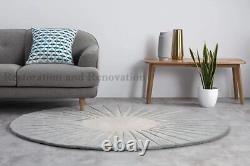
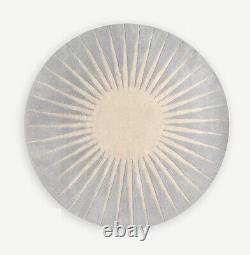
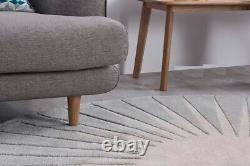
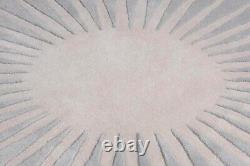
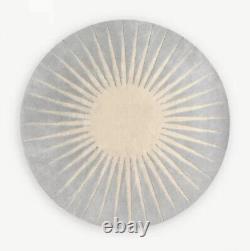


Hand-Tufted Rug: A Detailed Exploration. Hand-tufted rugs are a popular choice for home décor enthusiasts due to their unique combination of quality, versatility, and affordability. Unlike hand-knotted rugs, which require intricate craftsmanship and can take months or even years to complete, hand-tufted rugs offer a quicker production time without compromising on the aesthetic appeal and durability.
This makes them an ideal choice for those who want a luxurious look at a more accessible price point. Manufacturing Process of Hand-Tufted Rugs. The creation of a hand-tufted rug involves a blend of traditional techniques and modern tools, resulting in a rug that is both beautiful and sturdy. The process begins with a weaver using a tufting gun to punch strands of wool or other fibers through a pre-made fabric base, often a canvas. This base has a design sketched or printed on it, which guides the weaver in placing the fibers in the correct pattern. After the tufting process, the rug is reinforced with a layer of latex glue on the back to secure the tufts in place.This step is crucial as it ensures the rug's longevity and prevents the fibers from shedding or coming loose over time. A final layer of fabric is applied to cover the latex, giving the rug a clean and finished appearance on the back.
The exposed fibers are then sheared to create a uniform pile height, revealing the rug's intricate design and adding a soft texture underfoot. Materials Used in Hand-Tufted Rugs.
Hand-tufted rugs are crafted from a variety of materials, each offering unique characteristics that affect the rug's texture, durability, and overall appearance. Wool: Wool is the most frequently used material for hand-tufted rugs due to its softness, durability, and natural stain resistance.Wool rugs are known for their ability to retain color vibrancy over time, making them an excellent choice for high-traffic areas. Cotton: Cotton is often used as a secondary material or for the rug's backing. It provides flexibility and a soft texture while maintaining a reasonable level of durability. Cotton-backed rugs are lightweight and easier to move, which is ideal for those who like to rearrange their living spaces frequently. Synthetic Fibers: Materials such as nylon, polyester, and acrylic are also used in hand-tufted rugs.
These fibers are popular due to their affordability, stain resistance, and ease of cleaning. Rugs made from synthetic materials can mimic the look and feel of natural fibers while providing additional benefits like enhanced durability and moisture resistance.
Silk and Viscose: For a more luxurious feel, some hand-tufted rugs incorporate silk or viscose fibers. These materials add a subtle sheen and a softer texture to the rug, enhancing its visual appeal and making it a focal point in any room. One of the most compelling aspects of hand-tufted rugs is their wide range of designs and patterns. Because the tufting process allows for greater flexibility than traditional hand-knotting, artisans can create complex and detailed designs with ease.From traditional Persian and Oriental motifs to modern abstract patterns, hand-tufted rugs offer something for every style preference. Color is another significant factor in the design of hand-tufted rugs. These rugs are available in an extensive palette, ranging from neutral earth tones to vibrant, bold colors. This variety ensures that there is a hand-tufted rug to complement every interior décor style, whether you are looking for a subtle accent piece or a striking centerpiece.
The pile height and texture of hand-tufted rugs also contribute to their aesthetic appeal. Some rugs feature a high pile, giving them a plush, luxurious feel, while others have a low pile, offering a sleeker and more minimalist appearance. Additionally, hand-tufted rugs can incorporate varying pile heights within a single design to create a sculpted, three-dimensional effect, adding depth and interest to the rug's surface. Affordability: Compared to hand-knotted rugs, hand-tufted rugs are more affordable due to the faster production process. This makes them an excellent choice for those who want a high-quality, aesthetically pleasing rug without the hefty price tag.Durability: While not as durable as hand-knotted rugs, hand-tufted rugs are still highly durable and can withstand moderate to high foot traffic. The latex backing adds stability and prevents the fibers from pulling out, ensuring the rug maintains its appearance over time.
Versatility: Hand-tufted rugs come in a wide range of sizes, shapes, colors, and patterns, making them suitable for any room or décor style. Whether you need a rug for your living room, bedroom, dining area, or hallway, there is a hand-tufted rug that will fit your needs perfectly. Comfort: The thick pile of a hand-tufted rug provides a soft, cushioned feel underfoot, making it a comfortable choice for spaces where you may spend a lot of time standing or sitting, such as living rooms and bedrooms.Ease of Maintenance: Hand-tufted rugs are relatively easy to maintain. Regular vacuuming and spot cleaning are usually sufficient to keep them looking fresh and new.
Additionally, the latex backing helps protect against spills seeping through to the floor, making cleanup simpler and more effective. Care and Maintenance of Hand-Tufted Rugs.Proper care and maintenance are crucial to preserving the beauty and longevity of a hand-tufted rug. Here are some tips to help you keep your rug in excellent condition. Regular Vacuuming: To prevent dirt and debris from settling into the fibers, vacuum your hand-tufted rug regularly.
Use a vacuum cleaner with a rotating brush or beater bar, but avoid using high suction on the fringes to prevent fraying. Spot Cleaning: In the event of a spill, it's essential to act quickly. Blot the spill with a clean, dry cloth to absorb as much liquid as possible. Avoid rubbing, as this can push the stain deeper into the fibers. Use a mild detergent mixed with water to clean the affected area, and blot dry with a clean cloth.
Professional Cleaning: Depending on the amount of foot traffic and exposure to dirt, consider having your hand-tufted rug professionally cleaned every 12-18 months. Professional cleaning helps remove deep-seated dirt and allergens, restoring the rug's original color and texture. Rotation: To ensure even wear and tear, rotate your rug every 6-12 months. This is especially important for rugs placed in high-traffic areas or under furniture, as uneven exposure can cause certain sections to fade or wear out more quickly.
Avoid Direct Sunlight: Prolonged exposure to direct sunlight can cause the colors of your hand-tufted rug to fade over time. To prevent this, place your rug in a shaded area or use window coverings to block UV rays. Hand-tufted rugs can vary in their environmental impact depending on the materials used.
Wool, a common material for these rugs, is a renewable and biodegradable resource, making it an eco-friendly option. Additionally, many hand-tufted rugs are made using traditional techniques that require less energy compared to machine-made rugs, contributing to a lower carbon footprint. However, it is essential to be mindful of the use of synthetic materials and chemical treatments, such as dyes and latex backing, which can have environmental consequences. When selecting a hand-tufted rug, consider opting for those made from natural materials and dyed using eco-friendly processes. Additionally, look for rugs from manufacturers that adhere to ethical labor practices and sustainable production methods. Choosing the Right Hand-Tufted Rug for Your Space. Selecting the right hand-tufted rug for your home involves considering several factors to ensure it complements your space and meets your needs. Here are some key points to keep in mind. Size: Measure the area where you intend to place the rug and consider the furniture layout. A rug that is too small can make a room feel disjointed, while a rug that is too large can overwhelm the space. Aim for a rug size that allows all furniture pieces to sit comfortably on it or just the front legs, depending on the layout.Color and Pattern: Consider the existing color scheme and décor style of your room. A hand-tufted rug can serve as a statement piece or a complementary accent, so choose a color and pattern that enhances your space. Neutral colors and simple patterns work well in minimalist settings, while bold colors and intricate designs can add character to a more eclectic room. Material and Pile Height: Think about the level of comfort and durability you need based on the rug's intended use. For high-traffic areas like hallways and living rooms, a lower pile height and durable material like wool or synthetic fibers are ideal.
For bedrooms or areas where comfort is a priority, consider a higher pile rug with a softer texture. Shape: While rectangular rugs are the most common, hand-tufted rugs are available in various shapes, including round, square, and oval. Consider the shape of your room and the placement of your furniture when choosing the rug shape that best suits your space. Hand-tufted rugs offer a perfect blend of style, comfort, and affordability, making them a versatile choice for any home. Their wide range of designs, colors, and materials ensures there is a hand-tufted rug to suit every taste and need. By understanding the unique characteristics of hand-tufted rugs and following proper care and maintenance practices, you can enjoy their beauty and functionality for years to come.
